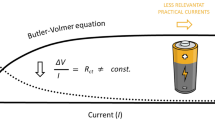Abstract
Currently, the developments and demands on high-capacity/high-power lithium-ion batteries (LIBs) are increasing owing to the advances in the eco-friendly electric vehicle industry. To improve the power and capacity of LIBs without changing material characteristics such as diffusivity and conductivity, it is effective to optimize design variables such as the electrode thickness, porosity, and active particle size. In this study, optimization to maximize the specific energy density was performed using the LIB electrochemical model and global optimization, which does not require gradient calculation. For many factors that affect the LIB power and capacity performance, major design variables were selected by performing sensitivity analysis using design of experiments. In addition, optimization was performed using the micro-genetic algorithm, which does not include mutation operation. Owing to the optimization, the anode/cathode capacity ratio was improved and the polarization phenomenon decreased, thereby increasing the specific energy density without changing the power performance compared with the initial design.









Similar content being viewed by others
Abbreviations
- \(a\) :
-
Ion number
- \(j_{n}\) :
-
Local current density (A/m2)
- \(k\) :
-
Electronic conductivity (S/m)
- \(\phi\) :
-
Electrical potential (V)
- \(R_{c}\) :
-
Gas constant, 8.314 [J/(mol K)]
- \(T\) :
-
Absolute temperature (K)
- \(F\) :
-
Faraday’s constant, 96,487 (C/mol)
- \(f_{ \pm }\) :
-
Average molar activity coefficient
- \(c\) :
-
Li concentration (mol/m3)
- \(t_{ + }\) :
-
Transport number of Li+
- \(r\) :
-
Radial distance from the center of electrode active particle (μm)
- \(D\) :
-
Diffusivity (m2/s)
- \(i\) :
-
Current density (A/m2)
- \(N_{0}\) :
-
Li+ flux (mol/m2 s)
- \(\eta\) :
-
Local surface overpotential (V)
- \(E_{cell}\) :
-
Specific energy density (Wh/kg)
- \(M_{cell}\) :
-
Mass of cell (kg)
- \(A_{cell}\) :
-
Cross-sectional area of cell
- \(V_{cell}\) :
-
Electric potential of cell
- \(\gamma\) :
-
Density (kg/m3)
- \(t\) :
-
Thickness (m)
- \(\varepsilon\) :
-
Porosity
- 1:
-
Solid phase
- 2:
-
Liquid phase
- n:
-
Negative electrode
- p:
-
Positive electrode
- s:
-
Separator
- el:
-
Electrolyte
- eff:
-
Effective value
- app:
-
Applied
References
Scrosati, B., & Garche, J. (2010). Lithium batteries: Status, prospects and future. Journal of Power Sources,195(9), 2419–2430.
Yu, D. Y. W., Donoue, K., & Inoue, T. (2006). Effect of electrode parameters on LiFePO4 cathodes. Journal of the Electrochemical Society,153(5), A835–A839.
Tran, H. Y. (2012). Influence of electrode preparation on the electrochemical performance of LiNi0.8Co0.15Al0.05O2 composite electrodes for lithium-ion batteries. Journal of Power Sources,210, 276–285.
Lu, W. (2011). High-energy electrode investigation for plug-in hybrid electric vehicles. Journal of Power Sources,196, 1537–1540.
Du, Z. (2017). Understanding limiting factors in thick electrode performance as applied to high energy density Li-ion batteries. Journal of Appled Electrochemistry,47, 405–415.
Doyle, M., Fuller, T. F., & Newman, J. (1993). Modeling of galvanostatic charge and discharge of the lithium/polymer/insertion cell. Journal of the Electrochemical Society,140(6), 1526–1533.
Doyle, C. M. (2010). Design and simulation of lithium rechargeable batteries. Berkeley: Lawrence Berkeley National Laboratory.
Srinivasan, V., & Newman, J. (2004). Design and optimization of a natural graphite/iron phosphate lithium-ion cell. Journal of the Electrochemical Society,151(10), A1530–A1538.
Xue, N., et al. (2013). Optimization of a single lithium-ion battery cell with a gradient-based algorithm. Journal of the Electrochemical Society,160(8), A1071–A1078.
Du, W., et al. (2013). Optimization of LiMn2O4 electrode properties in a gradient-and surrogate-based framework. Acta Mechanica Sinica,29(3), 335–347.
Golmon, S., Maute, K., & Dunn, M. L. (2012). Multiscale design optimization of lithium ion batteries using adjoint sensitivity analysis. International Journal for Numerical Methods in Engineering,92(5), 475–494.
Venter, G. (2010). Review of optimization techniques encyclopedia of aerospace engineering. vol 8. New York: Wiley
Arora, J. (2004). Introduction to optimum design. London: Academic Press.
Fouskakis, D., & Draper, D. (2002). Stochastic optimization: A review. International Statistical Review,70(3), 315–349.
Bayley, D. J., et al. (2008). Design optimization of a space launch vehicle using a genetic algorithm. Journal of Spacecraft and Rockets,45(4), 733–740.
Choi, B. C., et al. (2018). Kriging model based optimization of MacPherson Strut suspension for minimizing side load using flexible multi-body dynamics. International Journal of Precision Engineering and Manufacturing,19(6), 1–7.
Wu, W. (2013). A multiphysics model for the stress analysis of the separator in a lithium-ion battery. Diss, Michigan State University, Michigan, USA.
Krishnakumar, K. (1990). Micro-genetic algorithms for stationary and non-stationary function optimization. In 1989 symposium on visual communications, image processing, and intelligent robotics systems, International Society for Optics and Photonics.
Kawamura, T., Makidera, M., Okada, S., Koga, K., Miura, N., & Yamaki, J. (2005). Effect of nano-size LiCoO2 cathode powders on Li-ion cells. Journal of Power Sources,146(1), 27–32.
Drezen, T., Kwon, N.-H., Bowen, P., Teerlinck, I., Isono, M., & Exnar, I. (2007). Effect of particle size on LiMnPo4 cathodes. Journal of Power Sources,174(2), 949–953.
Acknowledgements
This research was supported by Konkuk University in 2016.
Author information
Authors and Affiliations
Corresponding author
Additional information
Publisher's Note
Springer Nature remains neutral with regard to jurisdictional claims in published maps and institutional affiliations.
Rights and permissions
About this article
Cite this article
Lee, DC., Lee, KJ. & Kim, CW. Optimization of a Lithium-Ion Battery for Maximization of Energy Density with Design of Experiments and Micro-genetic Algorithm. Int. J. of Precis. Eng. and Manuf.-Green Tech. 7, 829–836 (2020). https://doi.org/10.1007/s40684-019-00106-4
Received:
Revised:
Accepted:
Published:
Issue Date:
DOI: https://doi.org/10.1007/s40684-019-00106-4




